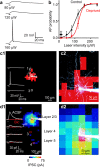Defining a critical period for inhibitory circuits within the somatosensory cortex
- PMID: 28779074
- PMCID: PMC5544762
- DOI: 10.1038/s41598-017-07400-8
Defining a critical period for inhibitory circuits within the somatosensory cortex
Abstract
Although experience-dependent changes in brain inhibitory circuits are thought to play a key role during the "critical period" of brain development, the nature and timing of these changes are poorly understood. We examined the role of sensory experience in sculpting an inhibitory circuit in the primary somatosensory cortex (S1) of mice by using optogenetics to map the connections between parvalbumin (PV) expressing interneurons and layer 2/3 pyramidal cells. Unilateral whisker deprivation decreased the strength and spatial range of inhibitory input provided to pyramidal neurons by PV interneurons in layers 2/3, 4 and 5. By varying the time when sensory input was removed, we determined that the critical period closes around postnatal day 14. This yields the first precise time course of critical period plasticity for an inhibitory circuit.
Conflict of interest statement
The authors declare that they have no competing interests.
Figures






Similar articles
-
Rapid Disinhibition by Adjustment of PV Intrinsic Excitability during Whisker Map Plasticity in Mouse S1.J Neurosci. 2018 May 16;38(20):4749-4761. doi: 10.1523/JNEUROSCI.3628-17.2018. Epub 2018 Apr 20. J Neurosci. 2018. PMID: 29678876 Free PMC article.
-
Somatosensory and visual deprivation each decrease the density of parvalbumin neurons and their synapse terminals in the prefrontal cortex and hippocampus of mice.Acta Med Okayama. 2013;67(3):135-43. doi: 10.18926/AMO/50406. Acta Med Okayama. 2013. PMID: 23804136
-
HDAC1 negatively regulates Bdnf and Pvalb required for parvalbumin interneuron maturation in an experience-dependent manner.J Neurochem. 2016 Nov;139(3):369-380. doi: 10.1111/jnc.13773. Epub 2016 Sep 15. J Neurochem. 2016. PMID: 27534825
-
Multiple shared mechanisms for homeostatic plasticity in rodent somatosensory and visual cortex.Philos Trans R Soc Lond B Biol Sci. 2017 Mar 5;372(1715):20160157. doi: 10.1098/rstb.2016.0157. Philos Trans R Soc Lond B Biol Sci. 2017. PMID: 28093551 Free PMC article. Review.
-
The Role of Inhibitory Interneurons in Circuit Assembly and Refinement Across Sensory Cortices.Front Neural Circuits. 2022 Apr 7;16:866999. doi: 10.3389/fncir.2022.866999. eCollection 2022. Front Neural Circuits. 2022. PMID: 35463203 Free PMC article. Review.
Cited by
-
Repeated maternal separation causes transient reduction in BDNF expression in the medial prefrontal cortex during early brain development, affecting inhibitory neuron development.Heliyon. 2020 Aug 26;6(8):e04781. doi: 10.1016/j.heliyon.2020.e04781. eCollection 2020 Aug. Heliyon. 2020. PMID: 32923721 Free PMC article.
-
GABA Measurement in a Neonatal Fragile X Syndrome Mouse Model Using 1H-Magnetic Resonance Spectroscopy and Mass Spectrometry.Front Mol Neurosci. 2020 Dec 18;13:612685. doi: 10.3389/fnmol.2020.612685. eCollection 2020. Front Mol Neurosci. 2020. PMID: 33390902 Free PMC article.
-
A databank for intracellular electrophysiological mapping of the adult somatosensory cortex.Gigascience. 2018 Dec 1;7(12):giy147. doi: 10.1093/gigascience/giy147. Gigascience. 2018. PMID: 30521020 Free PMC article.
-
Forever young: Neoteny, neurogenesis and a critique of critical periods in olfaction.J Bioenerg Biomembr. 2019 Feb;51(1):53-63. doi: 10.1007/s10863-018-9778-4. Epub 2018 Nov 12. J Bioenerg Biomembr. 2019. PMID: 30421031 Review.
-
Shifting Developmental Trajectories During Critical Periods of Brain Formation.Front Cell Neurosci. 2020 Sep 10;14:283. doi: 10.3389/fncel.2020.00283. eCollection 2020. Front Cell Neurosci. 2020. PMID: 33132842 Free PMC article. Review.
References
-
- Wiesel TN, Hubel DH. Effects of visual deprivation on morphology and physiology of cells in the cats lateral geniculate body. J Neurophysiol. 1963;26:978–993. - PubMed
-
- Wiesel TN, Hubel DH. Single-cell responses in striate cortex of kittens deprived of vision in one eye. J Neurophysiol. 1963;26:1003–1017. - PubMed
Publication types
MeSH terms
Substances
LinkOut - more resources
Full Text Sources
Other Literature Sources
Molecular Biology Databases

